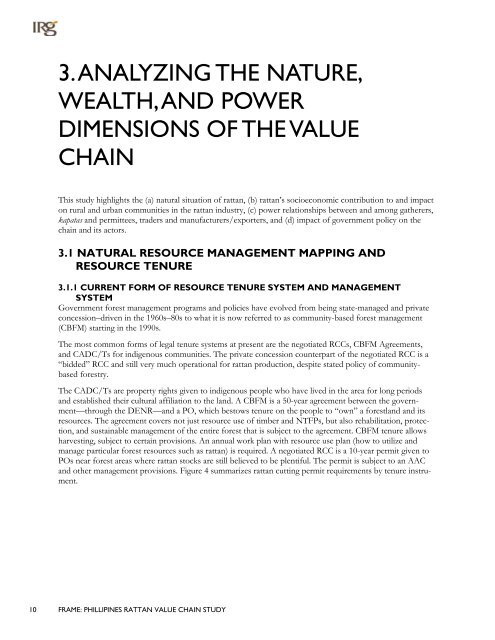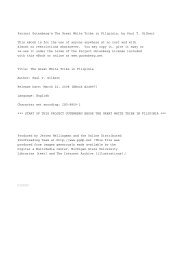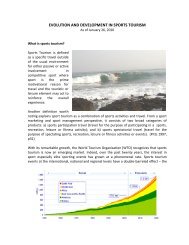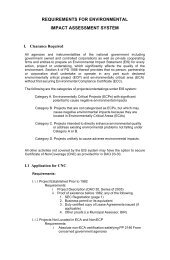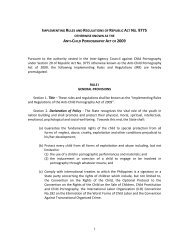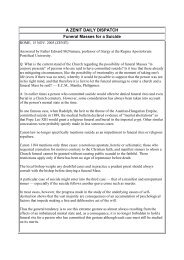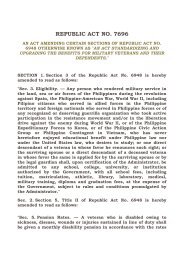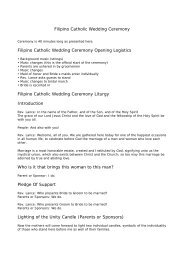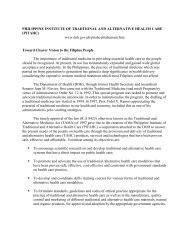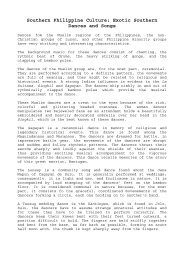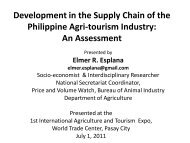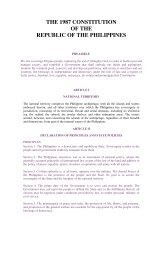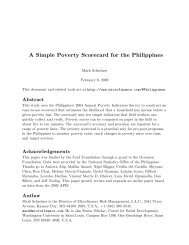PHILIPPINES RATTAN VALUE CHAIN STUDY - About the Philippines
PHILIPPINES RATTAN VALUE CHAIN STUDY - About the Philippines
PHILIPPINES RATTAN VALUE CHAIN STUDY - About the Philippines
Create successful ePaper yourself
Turn your PDF publications into a flip-book with our unique Google optimized e-Paper software.
3. ANALYZING THE NATURE,<br />
WEALTH, AND POWER<br />
DIMENSIONS OF THE <strong>VALUE</strong><br />
<strong>CHAIN</strong><br />
This study highlights <strong>the</strong> (a) natural situation of rattan, (b) rattan’s socioeconomic contribution to and impact<br />
on rural and urban communities in <strong>the</strong> rattan industry, (c) power relationships between and among ga<strong>the</strong>rers,<br />
kapatas and permittees, traders and manufacturers/exporters, and (d) impact of government policy on <strong>the</strong><br />
chain and its actors.<br />
3.1 NATURAL RESOURCE MANAGEMENT MAPPING AND<br />
RESOURCE TENURE<br />
3.1.1 CURRENT FORM OF RESOURCE TENURE SYSTEM AND MANAGEMENT<br />
SYSTEM<br />
Government forest management programs and policies have evolved from being state-managed and private<br />
concession–driven in <strong>the</strong> 1960s–80s to what it is now referred to as community-based forest management<br />
(CBFM) starting in <strong>the</strong> 1990s.<br />
The most common forms of legal tenure systems at present are <strong>the</strong> negotiated RCCs, CBFM Agreements,<br />
and CADC/Ts for indigenous communities. The private concession counterpart of <strong>the</strong> negotiated RCC is a<br />
“bidded” RCC and still very much operational for rattan production, despite stated policy of communitybased<br />
forestry.<br />
The CADC/Ts are property rights given to indigenous people who have lived in <strong>the</strong> area for long periods<br />
and established <strong>the</strong>ir cultural affiliation to <strong>the</strong> land. A CBFM is a 50-year agreement between <strong>the</strong> government—through<br />
<strong>the</strong> DENR—and a PO, which bestows tenure on <strong>the</strong> people to “own” a forestland and its<br />
resources. The agreement covers not just resource use of timber and NTFPs, but also rehabilitation, protection,<br />
and sustainable management of <strong>the</strong> entire forest that is subject to <strong>the</strong> agreement. CBFM tenure allows<br />
harvesting, subject to certain provisions. An annual work plan with resource use plan (how to utilize and<br />
manage particular forest resources such as rattan) is required. A negotiated RCC is a 10-year permit given to<br />
POs near forest areas where rattan stocks are still believed to be plentiful. The permit is subject to an AAC<br />
and o<strong>the</strong>r management provisions. Figure 4 summarizes rattan cutting permit requirements by tenure instrument.<br />
10 FRAME: PHILLIPINES <strong>RATTAN</strong> <strong>VALUE</strong> <strong>CHAIN</strong> <strong>STUDY</strong>


